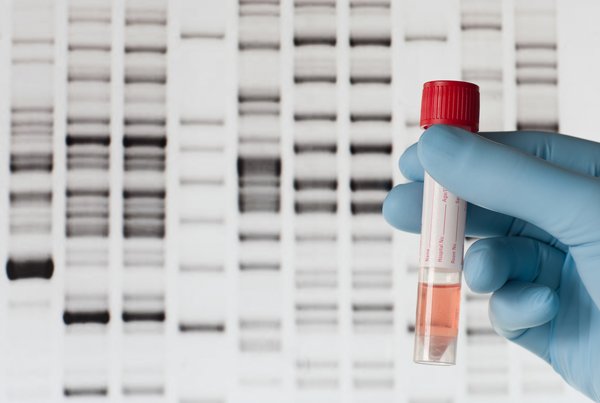
In 2020, American biochemist Jennifer Doudna and French microbiologist Emmanuelle Charpentier were awarded the Nobel Prize in Chemistry for their discovery of the CRISPR gene-editing technology. The Royal Swedish Academy of Sciences summed up the significance of their discovery by saying, “This year’s prize is about rewriting the code of life.”
Gene-editing companies using CRISPR technology have the potential to treat and even cure diseases caused by genetic variants. The gene-editing market is projected to reach $30.8 billion by 2032.
Best gene-editing companies to invest in
Best gene-editing companies to invest in
These are some of the gene-editing companies investors should have on their watch list:
| Company name | Company ticker | Market cap |
|---|---|---|
| Intellia Therapeutics | NASDAQ:NTLA | $677 million |
| CRISPR Therapeutics | NASDAQ:CRSP | $3 billion |
| Beam Therapeutics | NASDAQ:BEAM | $2 billion |
1. Intellia Therapeutics
1. Intellia Therapeutics
Intellia was co-founded by Jennifer Doudna in 2014. Its mission is to “develop potentially curative gene editing treatments that can positively transform the lives of people living with severe and life-threatening diseases.”
In 2021, Intellia and its partner, Regeneron Pharmaceuticals (REGN -2.9%), announced the first clinical data supporting the use of in vivo (in the body) CRISPR-Cas9 gene editing in humans. The two companies are now working together to evaluate nexiguran ziclumeran (formerly known as NTLA-2001) in a late-stage study targeting the rare genetic disease transthyretin amyloidosis (ATTR).
Intellia also has a wholly-owned late-stage candidate, NTLA-2002. It hopes to file for U.S. regulatory approval of the experimental therapy to treat hereditary angioedema in the second half of 2026 and launch it commercially in the U.S. in 2027.
In addition, Regeneron is evaluating a hemophilia B therapy licensed from Intellia in phase 2 clinical testing. Intellia will be eligible for milestone payments and royalties if the experimental therapy advances through clinical development and ultimately wins regulatory approval.
2. CRISPR Therapeutics
2. CRISPR Therapeutics
CRISPR Therapeutics was co-founded by Emmanuelle Charpentier in 2013. The company’s mission is "developing transformative gene-based medicines for serious human diseases."
CRISPR Therapeutics and its big partner, Vertex Pharmaceuticals (VRTX -0.55%), became the first to win regulatory approval for a CRISPR gene-editing therapy in December 2023 for Casgevy in treating sickle cell disease. The two companies won U.S. Food and Drug Administration (FDA) approval the following month for Casgevy in treating transfusion-dependent beta-thalassemia.
The commercial launch of Casgevy continues to gain momentum, with Vertex leading the charge. Meanwhile, CRISPR Therapeutics is working to advance several other gene-editing programs.
The company's pipeline includes two allogeneic chimeric antigen receptor T cell (CAR-T) therapies in clinical testing -- CTX112 and CTX131. Allogeneic (which means involving genetically different tissues or cells) CAR-T therapies are often referred to as "off-the-shelf" because they don't require a patient's own cells to be genetically edited and instead use cells from healthy donors.
CRISPR Therapeutics is evaluating two in vivo gene-editing therapies (where gene editing is performed inside the body) in early-stage clinical studies. The company is also conducting clinical testing of an experimental therapy for treating type 1 diabetes, with an update on this program expected in 2025.
3. Beam Therapeutics
3. Beam Therapeutics
Beam was co-founded by David Liu and Feng Zhang in 2017 with a vision of “providing life-long cures to patients suffering from serious diseases.” It is pioneering the use of base editing -- a potential new class of precision gene editing described as a “molecular pencil” that is able to erase and rewrite a mutation rather than slicing it out.
In March 2025, the company announced positive initial results from a phase 1/2 study evaluating its lead pipeline candidate, BEAM-302, in treating alpha-1 antitrypsin deficiency (AATD). AATD is a genetic disorder that affects the lungs and/or liver and can lead to emphysema and liver disease.
Beam's pipeline also features two other base-editing therapies in clinical development. The company is evaluating BEAM-101 in an early-stage study targeting sickle cell disease and BEAM-301 in another early-stage study targeting glycogen storage disease 1a, a rare disease where a sugar called glycogen builds up and affects organs.
Related investing topics
Investing in gene-editing stocks
Investing in gene-editing stocks
These three companies were started by clinical researchers to capitalize on the advancements in CRISPR gene-editing technology. CRISPR (pronounced “crisper”) is an acronym for Clustered Regularly Interspaced Short Palindromic Repeats. The name describes the DNA sequences spelling out the genetic code that guides the development of life.
CRISPR is based on the immune system that bacteria have developed to thwart viruses. The technique has been described as a “molecular scissor” honed in the battle of bacteria vs. virus over millions of years. When attacked by a virus, bacteria are able to target, slice, and destroy the DNA of the virus.
In 2012, American biochemist Jennifer Doudna and French microbiologist Emmanuelle Charpentier studied the phenomena and discovered how CRISPR-associated (Cas) proteins could be used to slice strands of DNA. At the same time, RNA molecules made in a lab could guide Cas proteins to exactly where to cut the DNA. The technique works in any cell and opens the possibility for gene editing in humans, plants, and animals.
The medical implications of CRISPR-Cas9 human gene editing are profound. The door is now open for using gene editing as a “one-and-done” treatment for a wide range of deadly and debilitating genetic conditions. In his New York Times best-seller The Code Breaker, author Walter Isaacson described CRISPR as changing "the future of the human race." (If you're unfamiliar with the book, you might start by watching The Motley Fool’s former healthcare bureau chief Corinne Cardina interview Isaacson on Fool Live.)
These gene-editing companies have the potential to be very successful. Both Intellia and CRISPR have found large pharmaceutical partners to help fund development and usher the new treatments to market. Beam is pursuing innovations that meaningfully address some of the challenges and shortcomings in CRISPR-Cas9.
Many investors find gene-editing companies complicated. Other investors find them too volatile, with prices stagnating for long periods and then moving strongly up or down depending on publicity about new research findings or the outcome of clinical trials.
One approach for starting to invest in gene-editing stocks is to consider a basket strategy of putting money into several companies and watching them progress over several years. Billions in market value will be created by companies with the ability to cure diseases.
For patient, buy-and-hold investors, gene-editing companies provide an opportunity to expand your portfolio during the coming genomic revolution.










